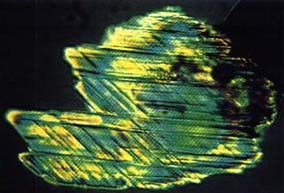Further Evidence Of An Asteroid Impact:
Osmium
Osmium consists of two isotopes Os187 and Os186.
Meteorites have a high concentration of Os 187. The K/T clay
of Gubbio was found to contain mostly Os187.
Spherules
Spherules which are the basaltic equivalent of tektites (balls of solidified molten rock) were found in the K/T clay.
Shocked quartz grains

Micron sized quartz grains containing shock lamellae (small fractures)
were found in the K/T clays. The only way to produce these shock lamellae is by high pressure shock
waves passing through rock. Shocked quartz grains have been found at nuclear weapons test sites
and asteroid impact sites such as Meteor Crater in Arizona.
Soot
Soot (small carbonaceous particles) was found in the K/T clays.
Soot is formed during forest fires. It can be hypothesized that this soot
was formed during the wild fires that spread on land after the asteroid
impact.
Clay composition
More clay of the K/T boundary was analyzed and found to contain 12 parts
of altered basaltic material to one part of meteoritic material (Carlisle).

| 
| 
|
Back to Asteriod Impact
| Back to Main Page
| Go To Volcanism
|






